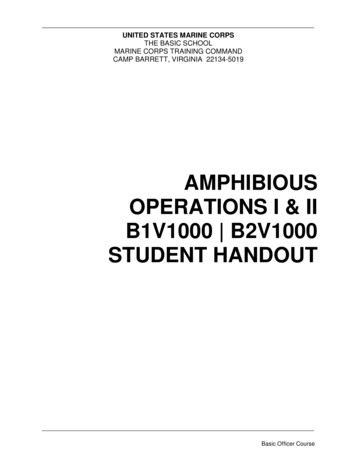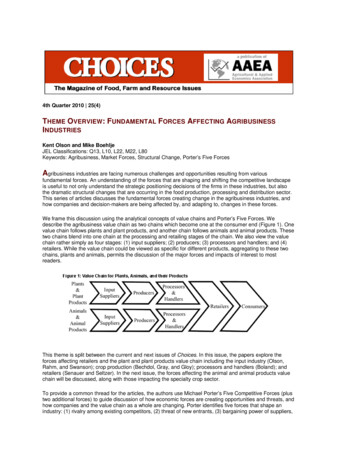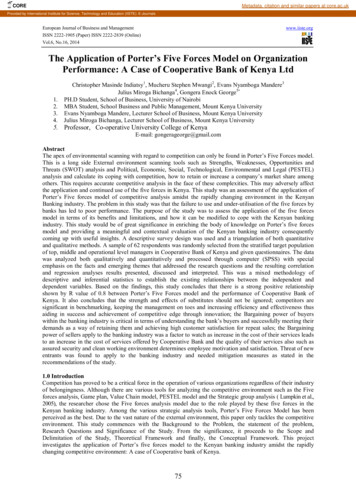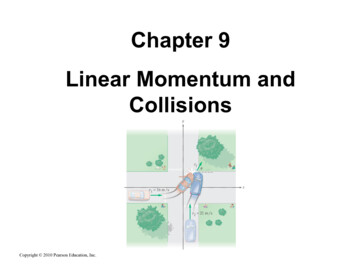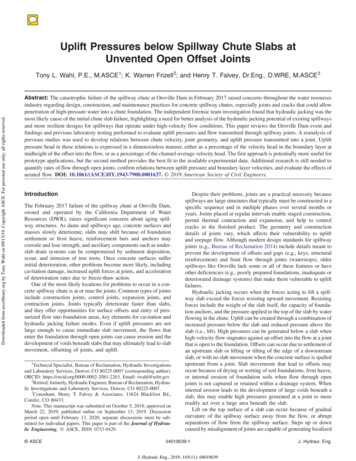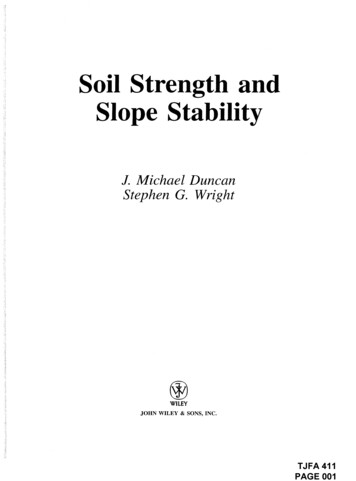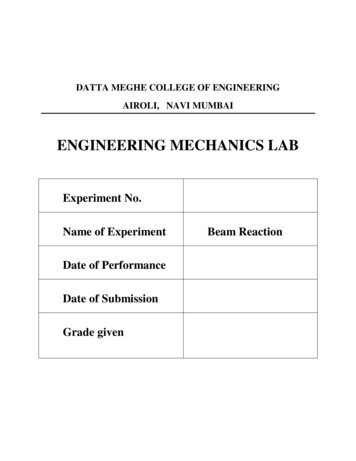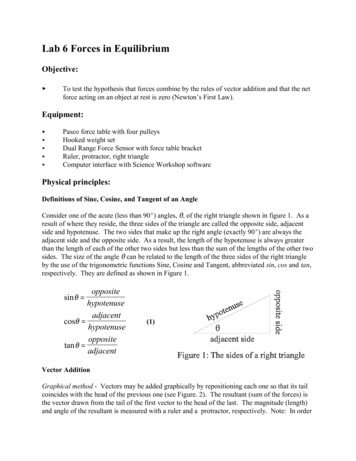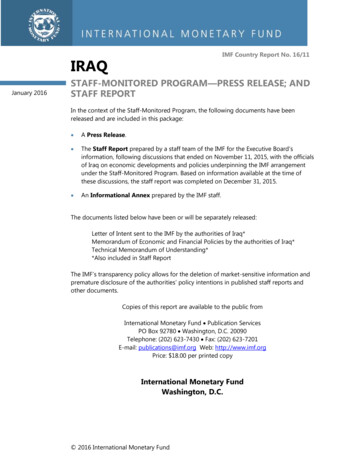
Transcription
U.S. Amphibious Forces:Indispensable ElementsofAmerican SeapowerU.S. Marine CorpsEllis GroupMarine Corps Combat Development Command3300 Russell RoadQuantico, VA 22134(703) 432-8380www.mccdc.usmc.mil
U.S. Amphibious Forces: Indispensable Elements of American SeapowerMARITIME and Amphibious capabilitiesAmerica’s maritime and amphibious capabilities are pivotal to the Nation’s ability todeter and defeat adversaries, strengthen alliances, deny enemies sanctuary and projectglobal influence. The Department of Defense’s 2012 strategic guidance, Sustaining U.S.Global Leadership: Priorities for 21st Century Defense, articulates key missions for theU.S. military to include rebalancing U.S. military posture to the Asia-Pacific region,establishing power projection, providing a stabilizing presence in key regions and undertaking humanitarian assistance.Evolving international security and domestic fiscal environments require the Nation’smaritime forward-deployed, crisis-response forces to innovate fearlessely. Meanwhile,the growing threat posed by conventional, irregular and asymmetric threats to ournational interests requires relentless adaptation in naval warfighting, littoral maneuver,and amphibious operations.While today’s force is highly capable, new challenges are proliferating from nations employing increasingly capable anti-access/area-denial (A2/AD) strategies. New conceptsand approaches –– such as the Single Naval Battle, an integrated naval expeditionarysystem, and broadened combined-arms special-operations integration –– are potentcounters to these emerging A2/AD threats. Future fights will likely be short-warning“come as you are” challenges posed by irregular adversaries.The Marine Corps/Navy Team will be prepared to maneuver swiftly from the sea toapply influence and power at a time and place of its choosing. The future force will bea “middleweight” expeditionary Marine Corps employing reinvigorated amphibiouscapabilities together with a Navy capable of maintaining forward presence, penetratingenemy anti-access defenses and ensuring maneuver at and from the sea.1
U.S. Amphibious Forces: Indispensable Elements of American SeapowerU.S. Amphibious Forces: Indispensable Elements of American Seapower“After reviewing [the January 2012 DefenseSecurity Guidance], it is very hard for me toimagine anyone thinking that maritime power,A New MARITIME OPPORTUNITYcapabilities, and capacities are not absolutelyU.S. amphibious forces play central roles in safeguardingThe 2012 Strategic Guidance for the 21st Century calls forAmerica’s global interests in peace, stability and security.innovative, low-cost and small-footprint means for cri-The increasing importance of the littorals and the grow-sis response, forward engagement and direct and indirectUnder Secretary of the Navy Robert O. Working complexity of maritime operations demand ceaselessapproaches to combat. The utility of naval amphibiousProceedings Magazine, May 2012innovation and new capabilities to ensure success. For-capabilities to a wide range of missions and tasks makesward engagement and partnership building, unparalleledthem essential tools for national decision makers and jointpower projection, assured littoral access, rapid responsecommanders at all levels. Maritime-response capabilitiesto crisis and an ability to sustain expeditionary operationsprovide a range of rapid intervention options that can befrom the sea are essential capabilities for the emerging na-tailored to the demands of each contingency. When cri-tional security environment.ses erupt, the persistent offshore presence of naval forcescentral to our national-security policy thinking.”If naval relevance is measured by its impact on human affairs, the Nation’s naval forces are standing at the thresholdof a “maritime moment” of opportunity. In a compellinghistorical parallel to the outburst of naval innovation thatoccurred between 1922-1940, the Marine Corps and Navyhave the opportunity to take the lead in the dawn of a new“Naval Century” and a “Golden Age” of U.S. seapower.while “buying” valuable time for leaders to evaluate options. While built for war, these same naval forces respond to humanitarian disasters, conduct noncombatantevacuations and set the conditions for enduring peaceand security in the maritime commons.Rebalancing to the Asia-Pacific region “places a renewedThe Marine Corps and Navy amphibious forces areready to strengthen their partnership with all of the Nation’s joint forces; more closely align its capabilities withU.S. Special Operations Forces and ensure the dominance of the Marine Air-Ground Task Force (MAGTF) inthe littorals.in critical world regions enables them to respond quicklyemphasis on air and naval forces,” according to the Defense Department’s January 2012 Defense Budget Priorities and Choices document that detailed changes in Pentagon spending during the next decade. The Marine Corps/Navy amphibious forces stand on the threshold of an erathat will place high demands on America’s maritime capabilities, particularly as the military rebalances to theAsia Pacific region.23
U.S. Amphibious Forces: Indispensable Elements of American SeapowerU.S. Amphibious Forces: Indispensable Elements of American Seapower“Our strategic concept and our organizationalconstruct is precisely aligned with the strategicrequirements for the 21st century. It is hardRethinking MARITIME OPERATIONSto imagine a more maritime-friendly strategicenvironment.”Under Secretary of the Navy Robert O. WorkJune 2012 Current Strategy Forum, Naval War College4Today’s maritime forces must be more efficient while retooling the essence of naval warfighting and maritimepower projection.opens a window for the innovation and evolution of 21stCentury warfighting.Exploiting opportunity in adversity is a hallmark of Marines. In the lean decades after World War I, the Corps,led by a small coterie of visionary leaders — most notably amphibious warfare pioneer Pete Ellis — rigorouslyexperimented with the then-novel concept of amphibious operations. These experiments became the dominantform of operations throughout the Pacific theater duringWorld War II. In the interwar years, the Marines developed the roots of modern counterinsurgency doctrine,epitomized by the still-referenced Small Wars Manual,first published in 1935. This embrace of new technologiesand new concepts continued during the Cold War, withMarines in the forefront of efforts to develop helicoptersand air assault, tiltrotor aircraft for long-range operationsand advanced amphibious vehicles. Seizing opportunityin times of adversity has historically resulted in vastly improved amphibious effectiveness and efficiency. R enewed emphasis on protecting the global commonsand ensuring littoral accessRecent combat operations have yielded tremendous innovation in the conduct of irregular warfare (IW), counter-piracy, theater security shaping and interagency processes. These lessons must now be reshaped for a securityenvironment characterized by the resurgence of regionalpower-politics, the expansion of modern military capabilities, challenges to U.S. battlefield dominance in spaceand information capabilities, social movements that driveglobal instability and the potential for continued weapons of mass destruction (WMD) proliferation. This maritime opportunity moment is created by a “perfect storm”of simultaneous strategic and economic challenges that E xpanded cyber and informational threatenvironmentsThis “perfect storm” is characterized by: Strategic rebalancing to the Asia and Pacific regions Significant reductions in defense investments A reinvigorated partnership between the Marine Corpsand the Navy I ncreasing importance on forward-deployed,small-footprint methods N ew aviation platforms that dramatically enhanceMAGTF maneuverability and reach I ncreasing demand for amphibious force and othertheater security training from allies and stakeholdersin the Pacific region I ncreased capabilities of the joint force promptingchange to MAGTF operating concepts S tate adversaries armed with integrated A2/ADcapabilities P roliferation of modern precision weaponry andCommand, Control, Intelligence, Surveillance andReconnaissance systems (C2ISR) to non-stateadversaries A generation of Marines who are culturally attunedto operational environments and have experienceintegrating their operations with the joint force, theinteragency community and partner military forces R elief from a decade of combat commitments toIraq and Afghanistan5
U.S. Amphibious Forces: Indispensable Elements of American SeapowerU.S. Amphibious Forces: Indispensable Elements of American Seapower“ amphibious forces ‘buy time’ and decision space for our national leaders in time ofcrisis. They bolster diplomatic initiatives byEvolving THREATS AND CHALLENGESmeans of their credible forward presence.”General AmosExpanded A2/AD strategies will greatly complicate thecalculus of how to gain and sustain access in joint campaigns. But the most likely use of American forces willcontinue to be in small-scale contingencies, requiring theNation’s maritime crisis-response forces to be forward deployed in a state of high readiness.memo to the Secretary of DefenseAs global power shifts horizontally to new states and regions, there are concurrent vertical shifts in power to nonstate (social, economic, religious, criminal, ethnic) entitiesthat challenge the very ideas of sovereignty, threats and security. While planning for conventional warfare remainsa prudent responsibility of the naval force, planning forthe unexpected and unconventional is a necessity.Regional challengers could necessitate larger-scale interventions. Economic competition will drive rising powers to compete for influence, resources and operationaladvantage. Some regimes will continue to undertake external provocations to achieve domestic political advantage. Potentially, these provocations include seeking tolimit U.S. freedom of action in international waters or theglobal commons. Proxy conflicts through non-state actors are also likely to aggravate regional power struggles.Regional contingencies that impact the stability of theglobal system could occur near any of the major littoralchokepoints worldwide.Impact: The interconnected global system cre-ates vulnerabilities and unintended effects fromeven the smallest regional disruptions. Efforts toensure access to contested global commons willrequire the ability to gain local superiority in air,maritime and land domains and electromagnetic and missile environments. Active securitycooperation with regional allies will be an effective offset to emerging competitors. The abilityto engage new allies through forces that do notrequire a large footprint ashore will maximizethis opportunity.Instability and crisis will be a persistent feature. Increasingglobal interconnectedness, shared awareness, informationtechnology and ubiquitous social media are predominantfactors driving global change. Emerging democraticmovements are welcome evidence of the global appeal ofthe power of liberty, but remove long-standing restraintson diverse national and sub-national forces. Failing governments will continue to struggle to control sovereignspaces, giving sanctuary to those who threaten neighboring states or the global commons.Impact: A core function of the naval force isthe ability to respond to crisis through forwarddeployed and rapidly concentrated forces. Protecting citizens and interests during local andregional instability will continue to place heavydemands on the naval force. Force capacity planning should include this significant aspect ofsteady state employment. Understanding threatand local conditions are important to determining “relevant” combat power in crisis response.Forward-deployed maritime forces shape thisoperational environment through security assistance, combined training, and other low-cost,small-footprint activities. Removing potentialsanctuaries for potential destabilizing entities isessential.6Non-state and hybrid actors increase the complexity. Theproliferation of A2/AD technology (weapons, cyber or informational) to non-state/hybrid opponents will prove adisruptive challenge to U.S. strategic objectives. A web ofsocial networks, religious sympathies, refugees and ethnicdiasporas enable non-state actors to move assets acrossinternational borders, enabling them to operate –– often unhindered and undetected –– worldwide. Irregularwarfare will be practiced not only in remote deserts orjungles but also in urban areas, with ready access to modern technology. Threat actors will use new informationtechnology for communications, surveillance, intelligencegathering, remote control weapons, information operations and command and control (C2). The cumulativeeffect of these trends is that hybrid enemies will be less7
U.S. Amphibious Forces: Indispensable Elements of American SeapowerU.S. Amphibious Forces: Indispensable Elements of American Seapowerpredictable, more difficult to deter and less susceptible totraditional forms of warfare.tions for placing forces ashore if required by theobjectives of the campaign. Littoral maneuver,as a methodology to bypass fixed defenses andexploit enemy seams, must overcome the potentially widening gap between ship and shore. Thenaval force must outmaneuver the enemy in theintellectual environment, not present an overmatch in firepower alone.Impact: Irregular warfare is here to stay. Despitea national inclination to avoid entanglement incrises and contingencies, ground forces have historically been required to control situations inthe human environment, even if their presenceis transitory. Hybrid forces may be able to avoidmany of the lethal effects of joint shaping byblending in with civilian populations, especiallyin urban environments. Although hybrid enemies have the ability to disrupt U.S. operations,their own human and information networks arevulnerable to exploitation. U.S. forces will notbe able to control the information environment,so they must be able to operate within it, at apace that out-cycles the enemy.“ like an affordable insurance policy,Marine Corps and Navy’s amphibious forces,Anti-access and area denial capabilities will expand. Therelatively few states with modern, integrated systems willpose the most lethal long-range anti-access threat. A larger number of threats will employ shorter-range, area-denial capabilities to impede access, cause U.S. casualties, intimidate allies or gain a better bargaining position. Statesand non-states alike have demonstrated a willingness toaccept casualties in an area denial campaign that establishes them as a credible counter to U.S. power. Whilemilitary technology is the most obvious form of A2/AD,unconventional methodologies will likely emerge including civilian “flash mobs,” human shields, blocked infrastructure, diplomatic restraints, economic penalties or thethreat of lost commerce or increased oil prices. Presenting a thicket of A2/AD obstacles –– cyber attacks, proxyorganizations, attacks on re-arming sites, diplomatic maneuvering or ally intimidation –– forces the United Statesto think of power projection in new ways. “Mutually assured economic disruption” will be a powerful anti-accesstool in the new and connected global society.Impact: The joint force will conduct counter-represent a very efficient and effective hedgeagainst the Nation’s most likely risks.”General Amosmemo to the Secretary of Defense,September 20118Terrorism and the proliferation of WMD. The verticaldiffusion of power to non-state entities potentially createssome with capabilities formerly reserved by states. Themost coveted of these is the possession and capability toemploy WMD. The presence of this threat in non-stateportfolios risks circumvention of many of the careful restraints practiced by states, making retaliatory responsedifficult. The proliferation of WMD among terrorists hassteep consequences.A2/AD operations to enable the objectives ofa campaign, not as an endstate in and of itself.The naval force must consider multiple A2/ADthreat constructs in order to be ready to react, especially as forward basing is diminished and U.S.conventional dominance is no longer a guarantee. A multi-domain force operating from thesea has the ability to advance sea control throughraids ashore against hidden targets, can disruptintegrated air defenses through naval surfacefires, and can use fleet aviation to create condi-Impact: The utility of forces that can operatewithout a large footprint ashore and can sustain themselves from the sea puts them at lowerforce-protection risk. Thus, the naval force mustbetter align complementary capabilities to thoseof special operations forces through greater collaboration, integration and realistic training between all Naval forces and Special OperationsForces before and during deployments. Forward deployed amphibious forces may be firstresponders to terrorist attacks or play a role inintercepting or containing the spread of WMD.A “battle of signatures.” Avoiding detection is key to winning. Units and platforms generate electronic, visual,audible, thermal, and informational signatures that mustbe managed. The increasing technical sophistication ofenemies is a threat to our buildup of forces in or neara theater of operations. The proliferation of precisionbattlefield weapons makes the consequences of being discovered hazardous, whether at the tactical or operationallevel. Many states have significant over-the-horizon,precision-strike systems, and the proliferation of shorterrange precision weapons on the tactical battlefield is evenmore widespread. In this environment, a detected signature creates a target.Impact: In the “battle of signatures,”deception,camouflage, mobility, dispersion, emission control and other signature-management capabilities will increase in importance. Where detection is likely, survivability from the effects offirst-strike weapons is a primary consideration.9
U.S. Amphibious Forces: Indispensable Elements of American SeapowerU.S. Amphibious Forces: Indispensable Elements of American Seapower“ amphibious ships are the most utilitarian platforms in the American fleet for crisisresponse. We project influence and combatpower ashore from these platforms ”Commandant’s Planning Guidance, 2010Single Naval Battle:AN INTEGRATED MARITIME PERSPECTIVESingle Naval Battle maximizes the power of naval forcesto meet the evolving warfighting needs of U.S. Combatant Commanders in the maritime domain. Single NavalBattle envisions sea control, littoral maneuver and powerprojection as cohesive and singular operation. This perspective strengthens naval forces and boosts their operational value by eliminating seams in the application ofnaval capabilities. Through this perspective lens to planning and execution provides broader naval context, servesto identify critical dependencies, optimize forces, ensurecompatibility, and increase partnerships.The same approach can be applied for missions beginningwith the setting operational conditions, building relationships and training of credible security partners throughforward-deployed engagement and ranging to major operations and forcible entry. Maximizing naval effectiveness within the joint force, Single Naval Battle offers anintegrated domain-spanning littoral capability to enablethe joint campaign.The naval force does not displace the multi-domain advantages of the joint force, but offers a joint commanderan integrated littoral capability to enable his campaign.Future operational environments will demand forces capable of operating in the littorals with a more discerning,scalable and practiced application of power.A Single Naval Battle perspective seeks to correct thetrend that has resulted in “stove-piped” naval capabilities.Organizations and warfare areas have been driving operational concepts, doctrine and plans that function in isolation of one another. This “stove-piped” paradigm favorscapability “silos” and choices between power projectionand sea control; or amphibious warfare or strike warfare.Integrating naval combined arms from earliest campaigninception, linking all naval capabilities together throughpurpose, timing and location, a force embracing SingleNaval Battle seeks to achieve maximize limited capacity inmultiple environments.The Single Naval Battle does not overlap the Air-Sea Battle(ASB) concept. In fact, ASB is an excellent example of10the power of a unified campaign approach embracingSingle Naval Battle. Countering A2/AD threats generallytake place at the start of a joint campaign. A Single NavalBattle approach thus places ASB in context for the rest ofthe naval force. A 21st-Century naval force will not conduct shaping and condition-setting missions in isolation.Rather, it will integrate supporting elements across theforce with overall campaign objectives in mind, addressing comprehensively critical questions: How does countering A2/AD capabilities impact force aggregation andcrisis response timelines? How can the multi-domain capabilities of the naval force be leveraged to asymmetricallydismantle A2/AD capabilities? How can the naval forceuse the amphibious component to enable sea control?The effects of sea control are relevant when measured bytheir impact on the population ashore. Sea control setsconditions for power projection, while power projectionenables or shapes the objectives of sea control. In somecases, limited-objective power projection (e.g., strikes,raids, lodgments) might enable the fight for area access.In addition, during phase zero, amphibious forces working with host nation forces may delay or prevent escalation. Placing elements of U.S. naval forces on allied soilor in allied ports could complicate an enemy‘s escalationcalculus. The naval counter-A2/AD campaign might include placing a small force ashore to deny key terrain tothe enemy, influence populations, close chokepoints, seizeand defend forward missile-defense sites or establish expeditionary airfields. Amphibious forces might facilitatesea control by operating on the landward side of a littoralshoreline, seeking out hidden A2/AD capabilities and denying enemy sanctuary.Single Naval Battle has direct implications for shared naval force development across DOTMLPF. Likewise, it willlikely have a significant impact on the way the Navy andMarine Corps man regional headquarters to include theJFMCC maritime operations center and how we educatethe naval force. At senior levels, the approach creates ademand for the development of operationally focused littoral warfighters from both Services.11
U.S. Amphibious Forces: Indispensable Elements of American SeapowerU.S. Amphibious Forces: Indispensable Elements of American Seapower“ your United States Navy and Marine Corps Team remains themost economical, agile and ready force immediately availableto deter aggression and respond to crises.”Commandant’s Posture Statement, March 2012The Future ofAMPHIBIOUS OPERATIONS & NAVAL WARFIGHTINGThe increasing complexity of littoral warfare and the diversity of maritime missions preclude “just add water”approaches to amphibious operations. The future navalforce must apply a spectrum of complex principles inforce development, training, exercises and application.12With increased global connectivity,anticipating,deterringand preventing conflict throughoperational preparation of theenvironment (OPE) becomes morepossible and also imperative.{Battlespace shaping through littoral maneuver providesour sea-based force with the ability to control the timingand tempo of an engagement as well as the geometry ofthe battlespace. It creates options for the force to applystrength against weakness, and to present a threat throughthe depth of the enemy‘s battlespace. Naval forces willchoose when to give battle and will exploit an advantagein one domain to create opportunity in another. Littoral maneuver can be employed to defeat A2/AD threats,create conditions for sea control and enable subsequentnaval operations. Littoral maneuver is fundamental tomodern amphibious operating concepts and relies heavily on multi-mission air and surface platforms.{Exercising the art of combined arms will take on addedsignificance as tech-savvy enemies and battlefield complexity increases. Naval forces must stimulate enemysystems, observe responses and strike with precision ––baiting an enemy with false targets, littoral maneuverdeception and disorienting enemy formations throughmulti-domain combined arms effects. The inherentadvantages of the naval force in air, maritime and landdomains are complemented by cyber capabilities, information operations, electronic warfare, littoral maneuver,rapid mobility, deception and stealth. Precision firepowerand massed capabilities remain essential. Complex futureoperational environments call for the greater integrationof a range of interagency capabilities into an expandedconcept of combined arms.Against a wide variety of opponents, naval forces have theinherent ability to pose threats over wide areas at a tempothat confuses most enemies. Using deception and surprise in multiple domains is a force-multiplying capability that strains the situational awareness of an enemy andcreates capability gaps in integrated systems. Naval forcescan use these effects to minimize collateral damage, counter information campaigns and reduce operational risk.Relevant combat power metrics based on expected threatsand conditions are more useful than generalized combatpower metrics when assessing the efficacy of combat systems and their associated schemes of maneuver. Often,smaller units or a transitory presence ashore can createeffects on an enemy once thought possible only throughlarger formations. For instance, firepower and mass willbe less critical in selected scenarios than mobility or precision. ISR and command and control will enable smallteams to achieve the effects of larger formations. Thecomposition of an assault echelon and the ratios of various modes of littoral maneuver must be dynamically determined through analysis of the threat and conditions.13
U.S. Amphibious Forces: Indispensable Elements of American SeapowerU.S. Amphibious Forces: Indispensable Elements of American SeapowerWith increased global connectivity, anticipating, deterring and preventing conflict through operational preparation of the environment (OPE) becomes more possibleand also imperative. The U.S. joint force must focus ondenying enemies sanctuary, enabling partner nation capabilities, strengthening regional alliances and creating solidrelationships that will endure through crisis. A practicedinteragency campaign of OPE activities leverages all elements of engagement toward a unified and satisfactoryend-state.In addition, the scalability and efficiency of the NavalExpeditionary System (NES) combines the diverse components of the expeditionary force into predictable, practiced, packages that can be rapidly applied. A mature NESsynchronizes the training, readiness and deployment ofnaval expeditionary forces. Its components would be determined by warfighting demand, steady-state missionsand training requirements. The NES is mature for thefrequently deployed mid-scale expeditionary forces suchas amphibious ready groups (ARGs) and Marine expeditionary units (MEUs). Expanding this concept to thecomponents of the expeditionary strike group (ESG) andMarine expeditionary brigade would be a natural progression. Where rapid aggregation of larger forces is required,the NES would provide building blocks that have trainedto the same standards, understand C2 relationships, haveinteroperable equipment and operate with common battlefield understanding. NES provides the common tactics, techniques, and procedures for intelligence, C2, fires,maneuver, logistics, and force protection. While this approach appears prescriptive, it is, in fact, the enabling element of task-organized arrangements in combat. Forcesmust be trained and exercised at each level to allow fororderly aggregation into a capable contingency or crisisresponse force.The Navy and Marine Corps have long recognized thatthe most effective way to build a force is through the flexible task organization of combined-arms teams. Modernmissions and response times suggest the utility of standing combined arms forces that require only tailoring onthe-margins when a specific mission is assigned. Standing MAGTFs, strike groups or larger naval formations,complemented by a range of specialized mission modules, would allow mission tailoring around a well-trainedand highly cohesive base. This principle of adaptive forcepackaging ensures necessary proficiency and unit cohesion and serves to enable rapid force generation anddeployment.“Our naval forces are at their best when they are forward, assuring allies and buildingpartnerships, deterring aggression without escalation, defusing threats without fanfare,and containing conflict without regional disruption.”Chief of Naval Operations Posture Statement, March 20121415
U.S. Amphibious Forces: Indispensable Elements of American SeapowerU.S. Amphibious Forces: Indispensable Elements of American SeapowerSeizing the MARITIME OPPORTUNITYThe Marines cannot succeed without the Navy. The Navythat will allow them to do both an integrated combinedcannot succeed without the Marines. The Nation can-arms attack, as well as the ability to conduct individualnot make do without either. The moment of maritimeattacks using mission type orders vice utilizing a central-opportunity in 2012 includes game-changing potentialized command and control network. The adversary willfor increasing the efficiency and effectiveness of the na-further complicate the targeting challenge by being ableval force. Those impacts readily extend to the joint forceto operate in a multitude of terrains (e.g. urban, jungle,and the interagency. Innovati
occurred between 1922-1940, the Marine Corps and Navy have the opportunity to take the lead in the dawn of a new "Naval Century" and a "Golden Age" of U.S. seapower. The Marine Corps and Navy amphibious forces are ready to strengthen their partnership with all of the Na-tion's joint forces; more closely align its capabilities with
